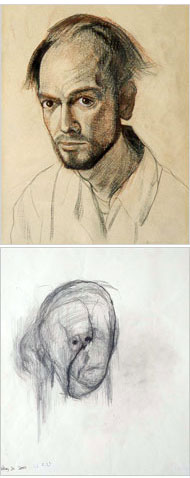
Really awesome article this morning in the NY Times about artist William Utermohlen, who after being diagnosed with Alzheimer’s Disease, began drawing/painting self-portraits. The self-portraits, viewed in chronological order, reveal the gradual deterioration of his mind and spirit.
Because Alzheimer affects the “right parietal lobe,” it gets harder and harder to visualize an image and be able to draw it. Art by Alzheimer’s patients becomes “more abstract, the images are blurrier and vague, more surrealistic” and “sometimes there’s use of beautiful, subtle color.”
Looking at these two pieces shoots cold lightning down my spine. It’s so hard to admit to yourself that something you think you do with your heart and soul is really just a bunch of wires connecting your hand to your brain. Maybe it’s for that reason that I find Alzheimer’s to be the most terrifying disease out there.
We’re machines, and machines break down.
I’m also wondering if this Chris Ware quote has any significance:
I see the black outlines of cartoons as visual approximations of the way we remember general ideas, and I try to use naturalistic color underneath them to simultaneously suggest a perceptual experience, which I think is more or less the way we actually experience the world as adults; we don’t really “see” anymore after a certain age, we spend our time naming and categorizing and identifying and figuring how everything all fits together.
And I hate to quote Franzen, but he what about this:
Scott McCloud, in his cartoon treatise “Understanding Comics,” argues that the image you have of yourself when you’re conversing is very different from your image of the person you’re conversing with. Your interlocutor may produce universal smiles and universal frowns, and they may help you to identify with him emotionally, but he also has a particular nose and particular skin and particular hair that continually remind you that he’s an Other. The image you have of your own face, by contrast, is highly cartoonish. When you feel yourself smile, you imagine a cartoon of smiling, not the complete skin-and-nose-and-hair package.
Even towards the end of his abilities, Utermohlen could still make a circle, two dots, and a horizontal line.
Even if it was the face of a ghost, it was still a face.
this reminds me of louis wain. you know him? he was an English painter in the 19th-century, and only painted cats. in his early years, the cats were high-society: playing crickets, drinking martinis, etc. then he developed schizophrenia. and the cats gradually started looking more paranoid and crazed, and by the time he was in the asylum, the cats looked like fractals…
i’ll hafta check him out